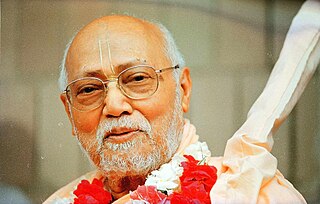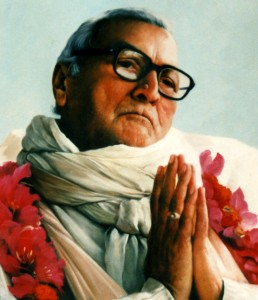
Bhaktisiddhanta Sarasvati, born Bimala Prasad Datt, was a Gaudīya Vaisnava Hindu guru, ācārya, and revivalist in early 20th century India. To his followers, he was known as Srila Prabhupāda.

Narottama Dasa Thakura, also known as Thakura Mahasaya, was a Gaudiya Vaishnava saint who was responsible for spreading Vaishnava bhakti throughout Odisha in and outside of Bengal in India. Narottama Dasa was the son of King Krishnananda Datta and Narayani Devi who resided in Gopalpur Pargana of the Rajshahi district of Bangladesh. According to some, after the death of his father he entrusted his royal duties to the eldest paternal uncle's son and left for Vrindavana.

The Gaudiya Math is a Gaudiya Vaishnava matha formed on 6 September 1920, about 30 months after Bhaktisiddhanta Sarasvati took sannyasa, the renounced order of life. On 7 March 1918, the same day he took sannyasa, he established the Sri Chaitanya Math in Mayapura in West Bengal, later recognised as the parent body of all the Gaudiya Math branches. Its purpose was to spread Gaudiya Vaishnavism, the philosophy of the medieval Vaisnava saint Chaitanya Mahaprabhu, through preaching and publishing.

Rupa Goswami was a devotional teacher (guru), poet, and philosopher of the Gaudiya Vaishnava tradition. With his brother Sanatana Goswami, he is considered the most senior of the six Goswamis of Vrindavan associated with Caitanya Mahaprabhu, a hidden avatar (incarnation) of Krishna in Kali Yuga.

Sanatana Goswami was a principal follower of Chaitanya Mahaprabhu. Sanatana wrote a number of important works in the bhakti tradition of Gaudiya Vaishnavism and was the seniormost of the influential Six Goswamis of Vrindavan, among whom was his brother Rupa Goswami.

Jiva Goswami was an Indian philosopher and saint from the Gaudiya Vaishnava school of Vedanta tradition, producing a great number of philosophical works on the theology and practice of Bhakti yoga, Vaishnava Vedanta and associated disciplines. He is known as one of the Six Goswamis of Vrindavan and was the nephew of the two leading figures, Rupa Goswami and Sanatana Goswami.

Bhaktisvarupa Damodara Swami, also known as Dr. Thoudam Damodara Singh and by the honorific Sripada, was a Gaudiya Vaishnava spiritual leader, chemist, writer about religion and science, and poet. In 1971 he received spiritual initiation from A. C. Bhaktivedanta Swami Prabhupada. A few years later he became one of the religious leaders of the International Society for Krishna Consciousness.

Radha Kund is a town and nagar panchayat in Vrindavan in the Indian state of Uttar Pradesh. It is also one of the pilgrimage sites dedicated to Hindu goddess Radha.

Bhakti Hridaya Bon, also known as Swami Bon, was a disciple of Bhaktisiddhanta Sarasvati and a guru in the Gaudiya Math following the philosophy of the Bhakti marg, specifically of Caitanya Mahaprabhu and Gaudiya Vaishnava theology. At the time of his death, he left behind thousands of Bengali disciples in India.

Bhakti Prajnan Keshava, addressed by the honorific Mahārāja, was a Gaudiya Vaishnava guru, disciple of Bhaktisiddhanta Sarasvati and the founder-acharya of the religious organisation "Sri Gaudiya Vedanta Samiti", formed in Calcutta in 1940, and its headquarters, monastery Sri Devananda Gaudiya Math in Nabadwip.

Jahnava Devi ; c. 1481 – c. 1541), also called Jahnava Mata, was the wife of Nityananda and a philosopher and saint from the Gaudiya Vaishnava school of Hindu Vedanta. She became a leading figure in Gaudiya Vaishnavism and a diksa guru and sampradaya head.
Brihad-bhagavatamrita is a sacred text for followers of the Hindu tradition of Gaudiya Vaishnavism. Along with Hari-bhakti-vilasa, it is one of the most important works of Vaishnava theologian Sanatana Goswami. While Hari-bhakti-vilasa sets out guidance for Vaishnava behavior and ritual, Brihad-bhagavatamrita contains an analysis of the teachings of Chaitanya from an ontological and metaphysical perspective.
Sat Sandarbhas is a 16th-century Vaishnava Sanskrit text, authored by Gaudiya Vaishnava theologian Jiva Goswami. The six treatise are Tattva-, Bhagavat-, Paramatma-, Krishna-, Bhakti-, and Priti-sandarbha. Jiva's Krama-sandarbha commentary on the Bhagavata Purana is often described as the "seventh" of the six sandarbhas.

An ISKCON guru is a person who is permitted to initiate disciples into the International Society for Krishna Consciousness system. The guru system has undergone several changes and reform since its beginnings in the 1960s. Upanayana as a traditional "sacred thread ceremony" of the Gayatri Mantra, commonly known Hindu Samskara, is complemented by Pancaratric mantras of the Gaudiya Vaishnava sampradaya and follows the principal initial nama initiation ceremony, referred to respectively as brahmana diksa and Hari nama diksa.

Sri Devananda Gaudiya Math is situated at Teghori Pada in Nabadwip dham of district Nadia in the West Bengal state of India, and is a matha and prominent holy place of the Gaudiya Vaishnavas, as well the headquarters of the Sri Gaudiya Vedanta Samiti. It is located in the middle of the place earlier known as Koladvipa. The Math has been continuing as a famous religious spot thronged by thousands of devotees every year.
This is a list of works by Bhaktisiddhanta Sarasvati (1874-1937), a Gaudiya Vaishnava leader and religious reformer. This list includes his original works, commentaries on canonical Vaishnava texts, and articles in periodicals Sajjana-toshani and the Gaudiya.

Bhakti Ballabh Tirtha was a disciple of Bhakti Dayita Madhava and an acharya and initiating spiritual master in the Gaudiya Math following the philosophy of the Bhakti marg, specifically of Caitanya Mahaprabhu and Gaudiya Vaishnava theology. He was the President Acharya of Sree Chaitanya Gaudiya Math, headquartered at Kolkata, West Bengal, India and having more than 22 branches in India. He was president of the World Vaisnava Association and founder of GOKUL.

Dr. Satyanarayana Dasa is an Indian Gaudiya Vaisnava scholar and practitioner. Dasa is a polymath, holding a Ph.D. in Sanskrit from Agra University, a degree in Indian law from Agra University, a Bachelors of Technology in Mechanical engineering from the Indian Institute of Technology and a Masters of Technology in Industrial Engineering from the Indian Institute of Technology. Currently based in India at the Jiva Institute, which he founded, Dasa has published numerous books and original papers in the field of Gaudiya Vaisnavism including translations and commentaries on the Sat Sandarbhas. His honors include an award from the President of India in 2012. Dasa has been called a leading living practitioner-scholar of Jīva Gosvāmin.

The Gaudiya Mission is a Gaudiya Vaishnava monastic and missionary organization whose founder acharya is Srila Prabhupad alias Srimad Bhakti Siddhanta Sarasvati Goswami Maharaja. The organisation has been registered since March 1940 in Calcutta, British India under the supervision of the then Acharya Srila Acharyadev alias Srimad Bhakti Prasad Puri Goswami Maharaj after accepting sannyasa in 1939/1941.

Bhakti Rakshak Sridhar was an Indian guru, writer, sannyasi and spiritual leader in the Gaudiya Vaishnava tradition of Chaitanya Mahaprabhu, founder-president-acharya of the Sri Chaitanya Saraswat Math.

















